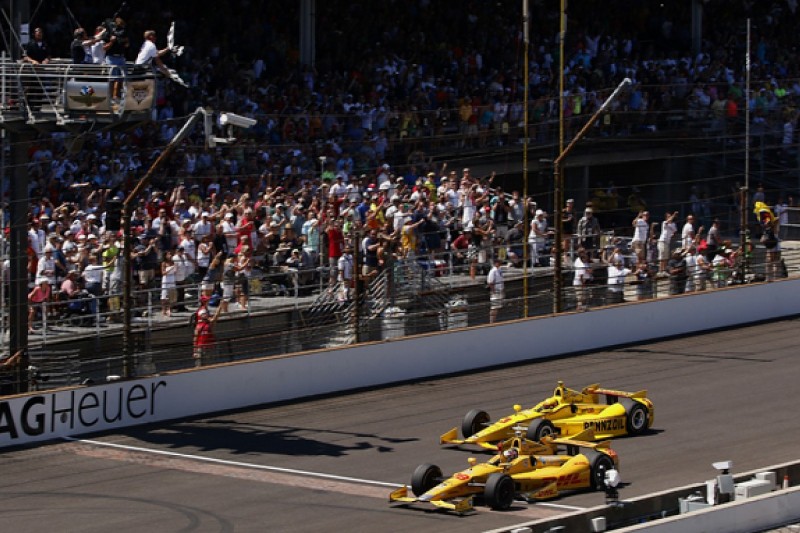Analysis: The drama at Indianapolis Motor Speedway
IndyCar is learning about its new, manufacturer-developed aero kits in public, while a series of high-speed aerial accidents overshadow the build-up to its centrepiece, the Indianapolis 500

Whether the kits have played any role in any of the accidents remains to be seen, but there are lessons to be learned, writes AUTOSPORT's IndyCar correspondent MARK GLENDENNING.
Frank Gardner used to tell a story about testing the Porsche 917. The laconic Australian racer and engineer would return to the pits after a run in a car that was, by all accounts, terrifying to drive in its early iterations, and would be swarmed by German engineers looking for feedback.
He'd explain what he'd felt the car doing, and the engineers would often interject with the readings they were getting: "Well, the computer says that the car's doing this..."
This began to wear thin with Gardner, and when the computer was mentioned once too often, the last threads of his patience finally snapped:
"The bloody computer isn't sitting there doing 300km/h with its arse an inch off the ground."
Computer simulations were in their infancy then, but even so, his basic point still rings true today: there's only so much that you can learn about a racecar without putting it onto a track.

And that's becoming a lesson that IndyCar is learning the hard way.
Whether you're a fan of the manufacturer-designed aero kits or not, the implementation has not been smooth.
The first race at St Petersburg was a chaotic debris-fest that ended with a spectator being hospitalised with a skull fracture after taking a piece of carbon fibre to the head.
And now, the build up to the Indy 500 - far and away the most important weekend in IndyCar's year - has been overshadowed by a string of huge accidents
IndyCar is yet to establish a definitive link between any of the crashes and the new aero kits.
The impact that left James Hinchcliffe in hospital certainly had nothing to do with his bodywork, and nor did Pippa Mann's accident earlier in the week.

The precautionary measures that the series took ahead of qualifying last weekend, when it lowered the engine power and mandated that cars race in the aero configuration that they qualify with - effectively forcing everyone to qualify in race trim - were reasonable given the circumstances.
But there is going to be increasing scrutiny over how these circumstances were allowed to develop in the first place.
Only six days of two-car track testing were permitted to each manufacturer during the development of the kits, and every new unanswered question is making that allocation look incrementally inadequate.

And the series' reaction to the situation has been poor.
It took five days and three crashes before IndyCar offered an official response, and that was more than enough time for it to lose any hope of controlling the narrative. In PR terms, that's a disaster.
In time, IndyCar and its manufacturers will figure out whether there's a common ingredient to any of those crashes, and if measures are needed, they'll be swiftly taken. The series tends to be good like that.
But that doesn't solve the problem of how the series allowed itself to get into the position, and this is becoming a recurring theme with IndyCar.
The shambolic return to Houston a couple of years ago was inevitable as soon as someone signed off on a contract that gave the promoter just a few days to build an entire circuit.

And, as Frank Gardner shows us, we've known for decades that computers are useful tools, but mere tools nonetheless.
Qualifying weekend for the world's biggest race should not be the first time that a series starts to wonder whether an aero package has some sneaky problem that the simulations didn't spot.
I hope that the current investigations conclude that the aero kit was blameless, because IndyCar can only absorb so many blows to its credibility.
The series has done a fantastic job in so many respects to restore itself over the past few years, and yet its propensity to keep stepping on rakes beggars belief.
And if the aero kit is indeed a non-factor, then I hope that IndyCar still treats the past week as an opportunity to learn a few lessons, both in how to introduce a major technical change, and in how to stop a story from ballooning out of its control.
But most of all, I just really hope that when I'm writing AUTOSPORT's race report for the 500 on Sunday afternoon, the only thing I'm thinking about is the amazing spectacle that I just witnessed.
The Indianapolis 500 deserves no less.

Be part of the Autosport community
Join the conversationShare Or Save This Story
Subscribe and access Autosport.com with your ad-blocker.
From Formula 1 to MotoGP we report straight from the paddock because we love our sport, just like you. In order to keep delivering our expert journalism, our website uses advertising. Still, we want to give you the opportunity to enjoy an ad-free and tracker-free website and to continue using your adblocker.














Top Comments